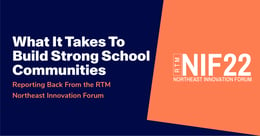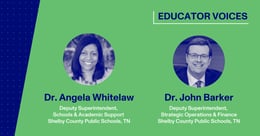
5 Strategies for Promoting Well-Being Throughout Your School Community
Think about the people who make up your entire school community—the staff, faculty, students, parents, and administrators—everybody who’s connected to the district. While we’re all joined in the pursuit of education, every person in the community has a complex life to lead, and school is a single, though critical, part of that multifaceted experience.
Now ask yourself this: What are you doing to make sure every one of those individuals is prepared to meaningfully engage with the core mission of learning?
Recently, at the National Conference on Education (NCE), presented by The School Superintendents Association (AASA), Paper Director of Educational Leadership Lydia Martinez moderated a panel where superintendents P.J. Caposey and Rick Surrency discussed strategies for promoting well-being within their districts.
Sharing insights gleaned from stakeholders in their Florida and Illinois communities—as well as from their own families—the conversation provided useful insights about how school leaders can navigate difficult times and prepare for the future.
1. Help students manage academics—and stress—outside of school hours
What happens after the final bell for the school day rings?
Students may stay late for sports and after-school activities, meaning study time will have to wait. Even without athletics and extracurriculars, some learners may just work best in the evening hours.
“High school students have a different schedule than a lot of us,” Surrency noted.
In particular, the challenges posed by the pandemic have meant that students often need additional time and support—in the classroom, at home, in the evening, and during the summer. Providing students with greater flexibility gives them a better chance to take charge and truly own their learning.
“I think we are really looking at learning now as being intrinsically—as opposed to extrinsically—motivated,” said Surrency.
Finding inspiration in the work of author Daniel Pink, the superintendent cited three key components as being essential drivers of motivation:
- Autonomy.
- Mastery.
- Purpose.
Inquiry-based academic interventions that take place on a student’s schedule—whenever that may be—can help individuals gain confidence in their ability to guide their own learning.
“There are solutions and there’s innovation taking place,” said Caposey. “That’s going to allow us to serve kids differently—and not just differently, but serve kids on their terms, which is vastly different from what we’ve traditionally done.”
2. Give teachers a boost
Of course, students aren’t the only ones who have felt the brunt of the pandemic. Teachers have had to navigate an abrupt sea change over the past two years, and those monumental efforts don’t come without strain.
“We turned the battleship around in the harbor,” said Caposey.
Handing teachers back their time—thoughtfully
While discussing issues related to teacher fatigue and burnout in a principal certification course he was teaching, Caposey realized there seemed to be a disconnect between classroom teachers and the well-intentioned administrators who were seeking to acknowledge their impressive contributions.
The class shared with the superintendent that it boiled down to delivering something substantial—not just trying to say the right thing at the right time—while still being mindful of the potential for unintended consequences.
“In a lot of places, all of a sudden, teachers became a 24/7, on-demand service for kids,” said Caposey. “Then it changed back when we went back to school, but it was like someone forgot to tell the teachers to forgive themselves of that responsibility.”
The superintendent was also careful to note that administrators have to be mindful of how they go about giving teachers back their time, respecting their authority over issues that they’ve fought to be able to oversee in the past.
Placing trust in our teachers
By using new academic tools in the classroom, like live support and essay review from Paper, Surrency shared one example of how teachers can reclaim some of that much-needed time.
He also added that demonstrating trust is an indispensable tool for administrators who are looking to support the well-being of their teachers in a meaningful way.
“I think that contributes to goodwill and good mental health because they know they’re in a place where people care about them,” said Surrency. “And I think when we do that, that’s going to be transmitted to our students too. We want our students to trust our teachers as well. So I think that’s a paradigm shift we all need to think about.”
3. Infuse joy and curiosity into learning
Throughout the pandemic, disruptions in education were often matched by changes taking place outside of school. Some students took on part-time jobs to help support their families, and many had to contend with additional stressors.
After such a long period away from the social and educational environment of school buildings—with other issues often competing for their attention—how are learners readjusting to being in the classroom consistently?
“I do have a lot of concern about how kids are going to view school,” said Caposey. “Our question right now as leaders is, what are we doing to inspire belief, inspire joy, and create connection within our buildings?”
Focus on shaping student purpose
One way or another, our students have had a glimpse of a different educational model, so now more than ever, they’ll want to know why we’re doing things the way we are. Bolstering curiosity is a key way to keep them engaged.
Noting that his district has seen a lot of improvement in graduation rates lately, Surrency pointed out the need to prepare students for life after high school. By facilitating exposure to concepts in science, technology, engineering, and mathematics (STEM) from an early age—and by ensuring widespread interaction with career and technical education (CTE)—his district offers a strong career focus in the classroom.
“Kids need purpose, and we, as educators, need to provide that purpose,” said Surrency. “Kids will own their learning if they know what their purpose is.”
The administrator also highlighted the importance of student voice, encouraging superintendents in the audience to establish student advisory committees if they haven’t done so already.
4. Ensure equity and access
One thing was abundantly clear from the conversation at NCE: The pursuit of equity demands that schools meet students where they are—without assumptions, judgment, or predisposition. Whether in the form of language accessibility or internet connectivity, administrators have to make sure they’re in touch with student needs and working diligently to provide them with the tools they need to thrive.
Critically, this means moving away from a deficit orientation.
Speaking from a place of personal experience, Surrency described how his young granddaughter, who has Rett syndrome, uses an eye-tracking machine to communicate.
“To me, that is what equity is all about—finding kids where they are,” said Surrency. “We as educators have to find them where they are and give them the best opportunity to learn.”
The role of advocacy
Caposey conceded that his district had to play some catch-up when COVID-19 hit. While devices were already in the hands of students, not everybody in the community had a suitable internet connection at home.
This issue was a learning experience in more ways than one. The onus was on the administration to lead this charge, and it would have been beneficial to act sooner—something that many districts were discovering simultaneously. Looking back, he also realized that his office hadn’t received any complaints from community members about a lack of home internet access when the devices were first rolled out.
It occurred to him that many parents who are more than willing to advocate for their students may not know how to work the levers of power so they can influence decision-makers.
“I think we have a moral imperative to understand that equity is about access and equity is about advocacy,” said Caposey. “With every decision we make, we're either closing the equity gap or we're perpetuating the equity gap. To me, there are no neutral decisions.”
5. Break down barriers so students can build habits for lifelong learning
Looking beyond this school year and the next, the superintendents reflected on what their districts are doing to cultivate lifelong curiosity in their scholars.
“I tell our teachers that every single one of our students needs to have at least one adult in that school they can connect with,” said Surrency.
Providing meaningful and positive interactions with staff members helps students to be fully present during the school day. They may have outside stressors that are weighing on them, but the ability to feel truly seen in the school community can have immense benefits.
Surrency also noted his district has used recent funding opportunities to reinvest in counseling support for students.
Caposey discussed the concept of wraparound services and how innovative academic supports have an important role to play, emphasizing that they need to be flexible enough to truly meet student needs.
“What are we doing to ensure all learners have the ability to continue to learn whenever it’s appropriate for them?” Caposey asked the audience.
By making sure that students always have the chance to expand their understanding, districts can help open up pathways to lifelong learning, encouraging their scholars to continue growing and exploring throughout their lives.
Taking the next step
We’d like to thank P.J. Caposey, superintendent of Meridian Community Unit School District #223, and Rick Surrency, superintendent of Putnam County School District, for sharing their thoughts on how to promote well-being in school communities.
Curious to learn more about how leading school districts are solving the most important problems in education today? Check out our free K-12 leadership guide.






